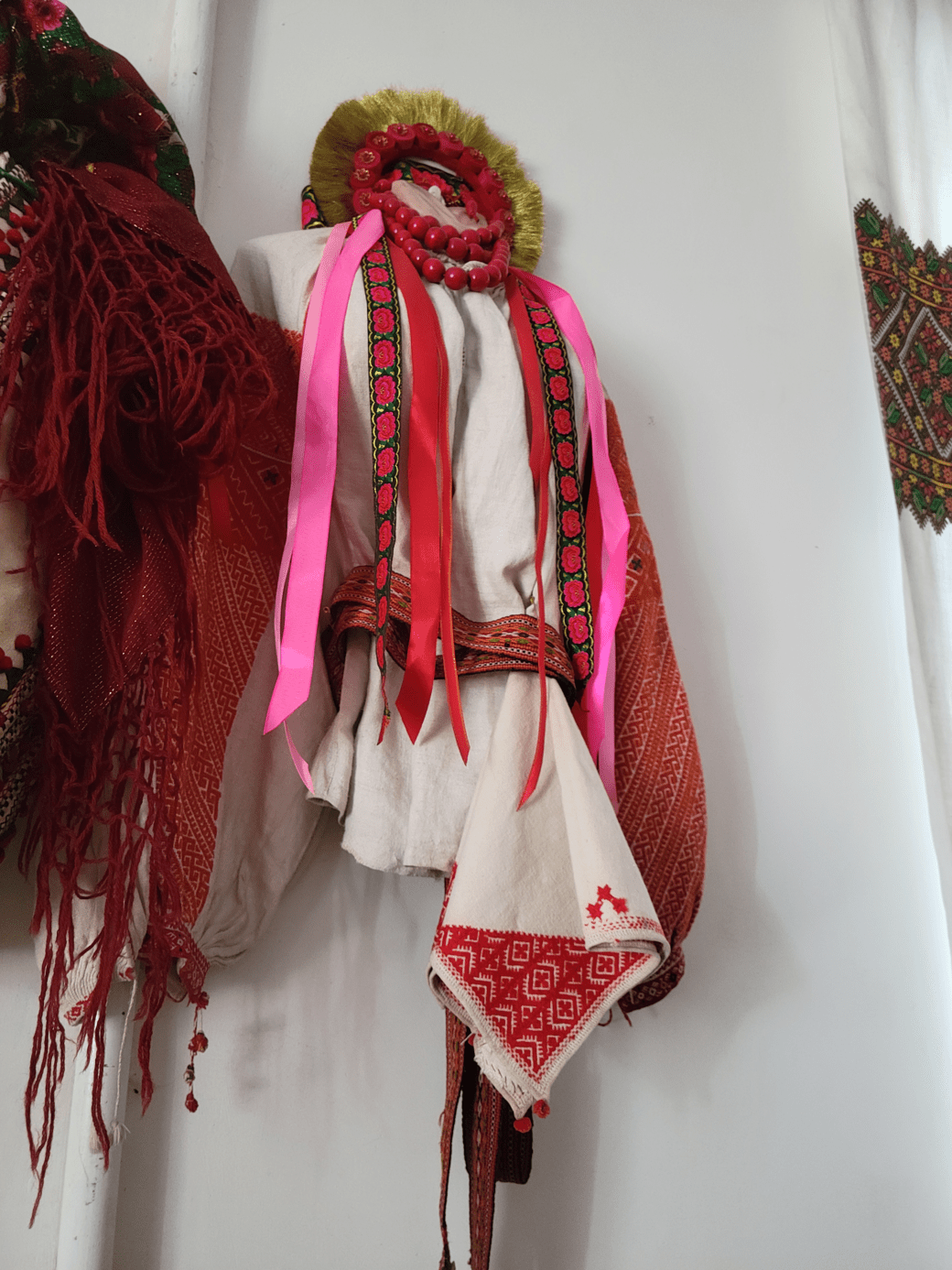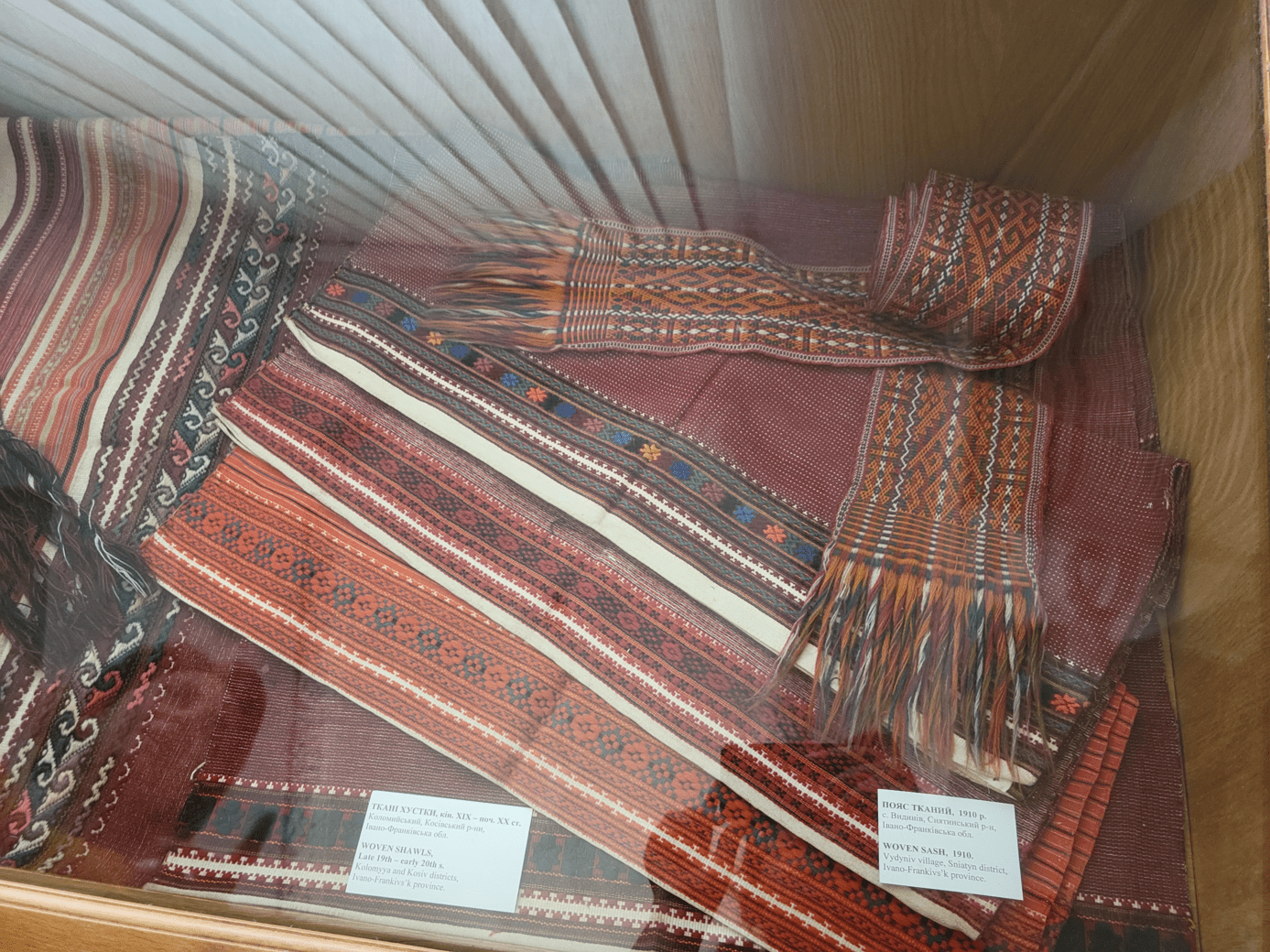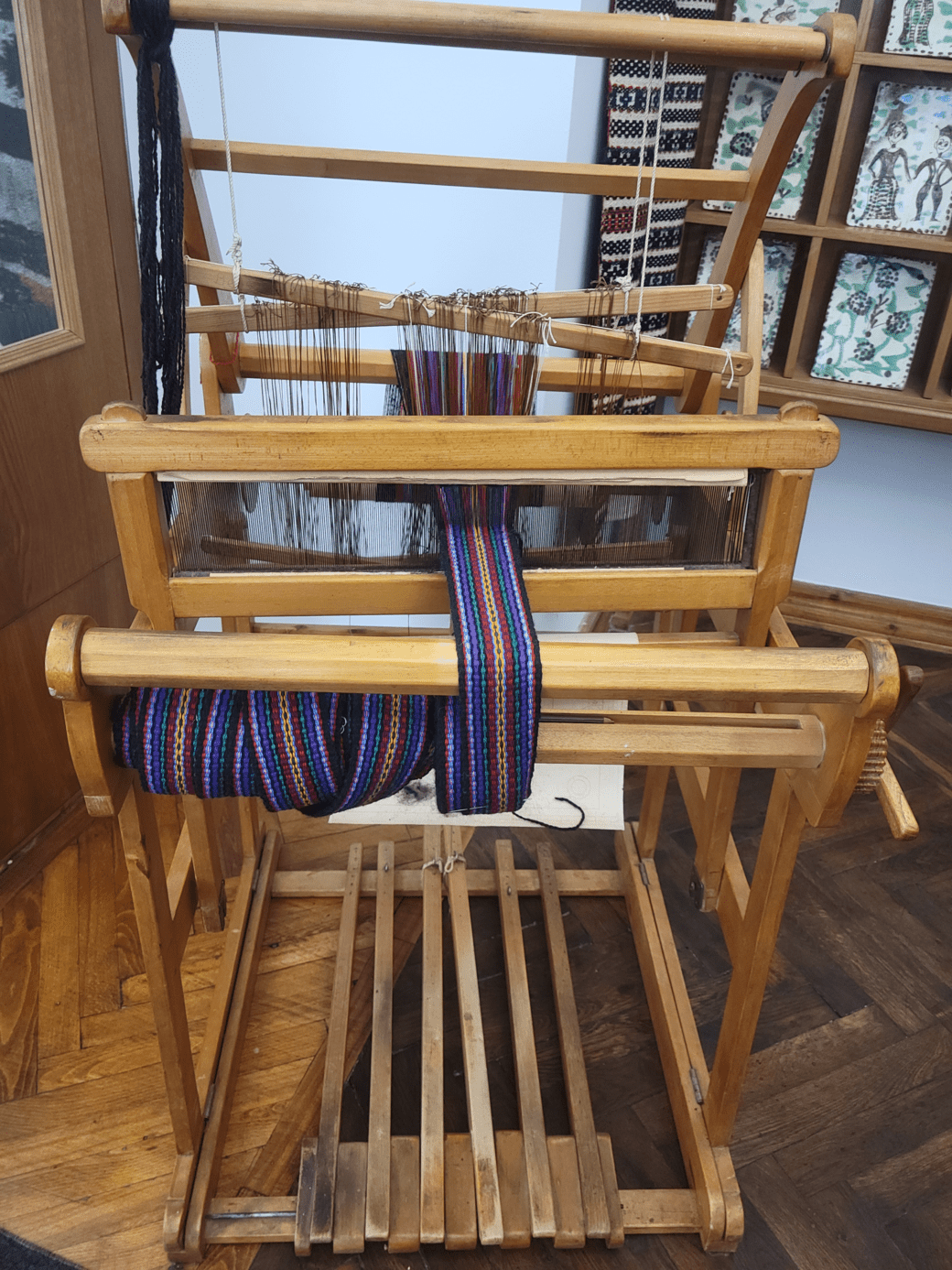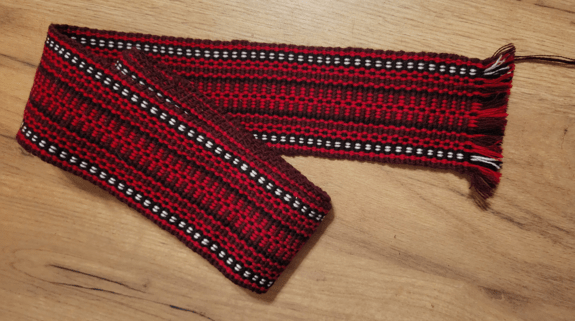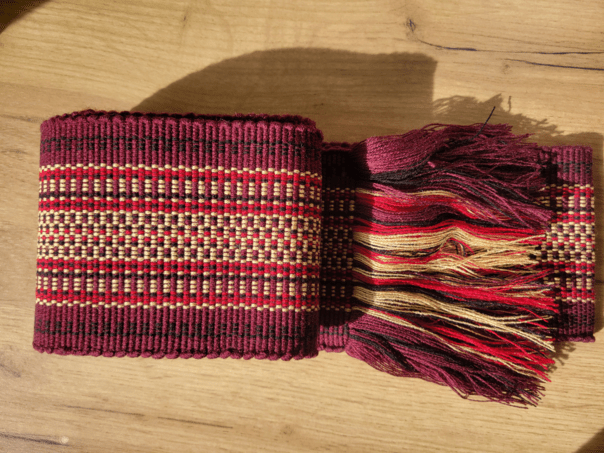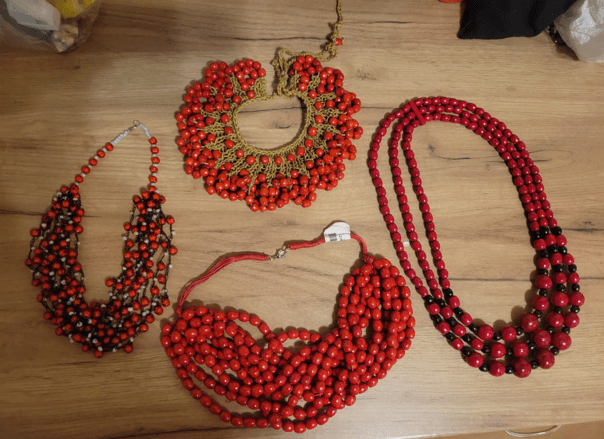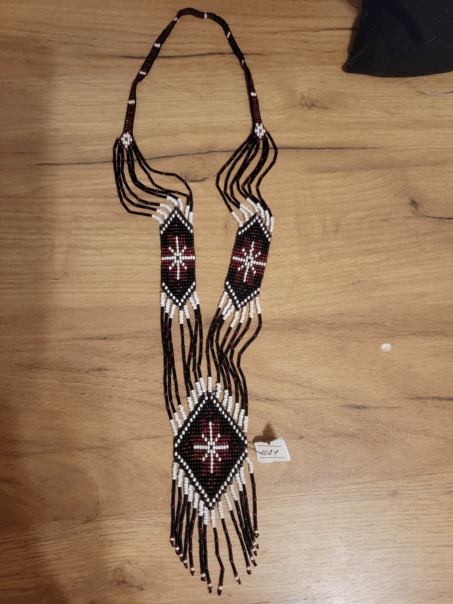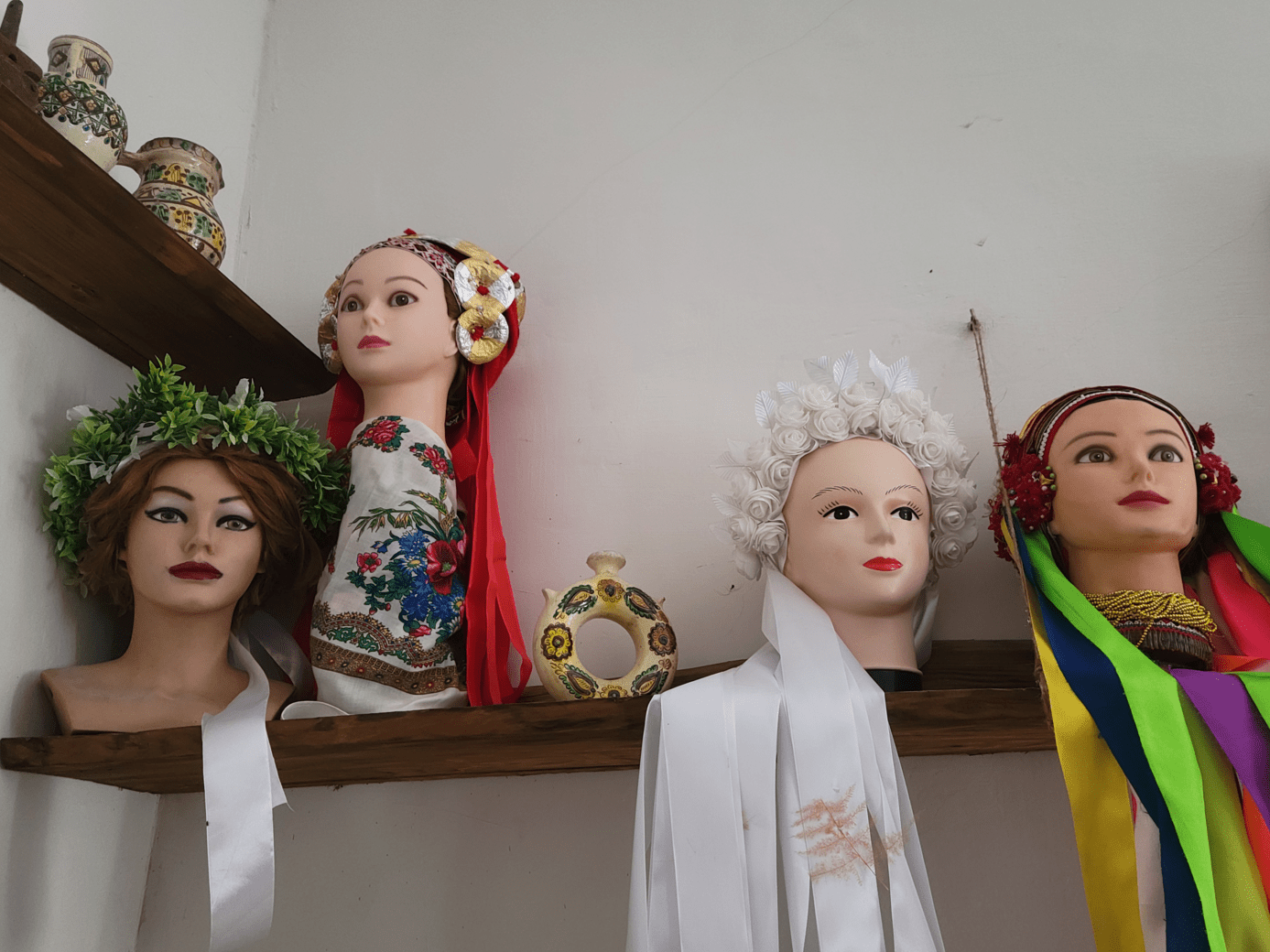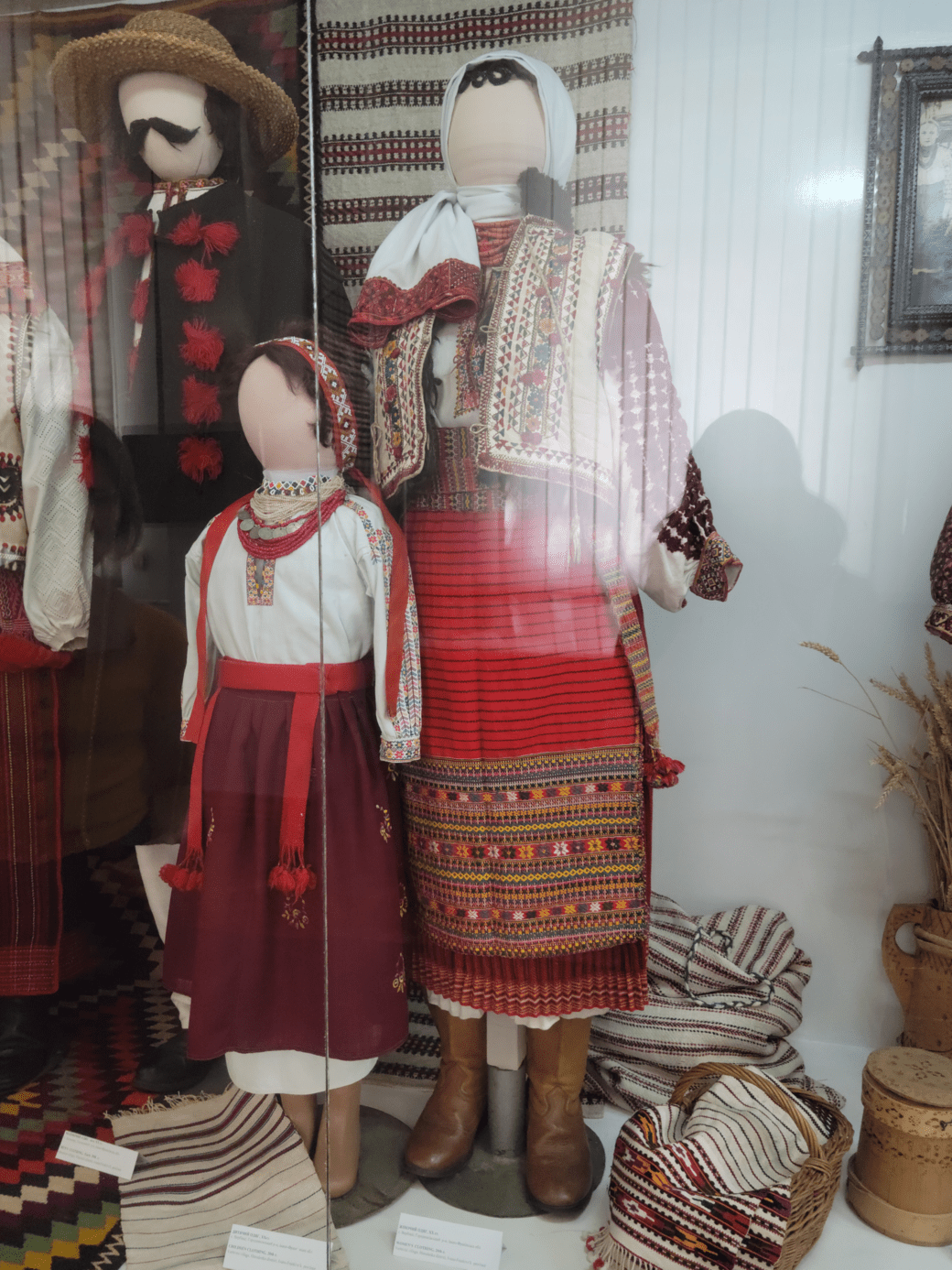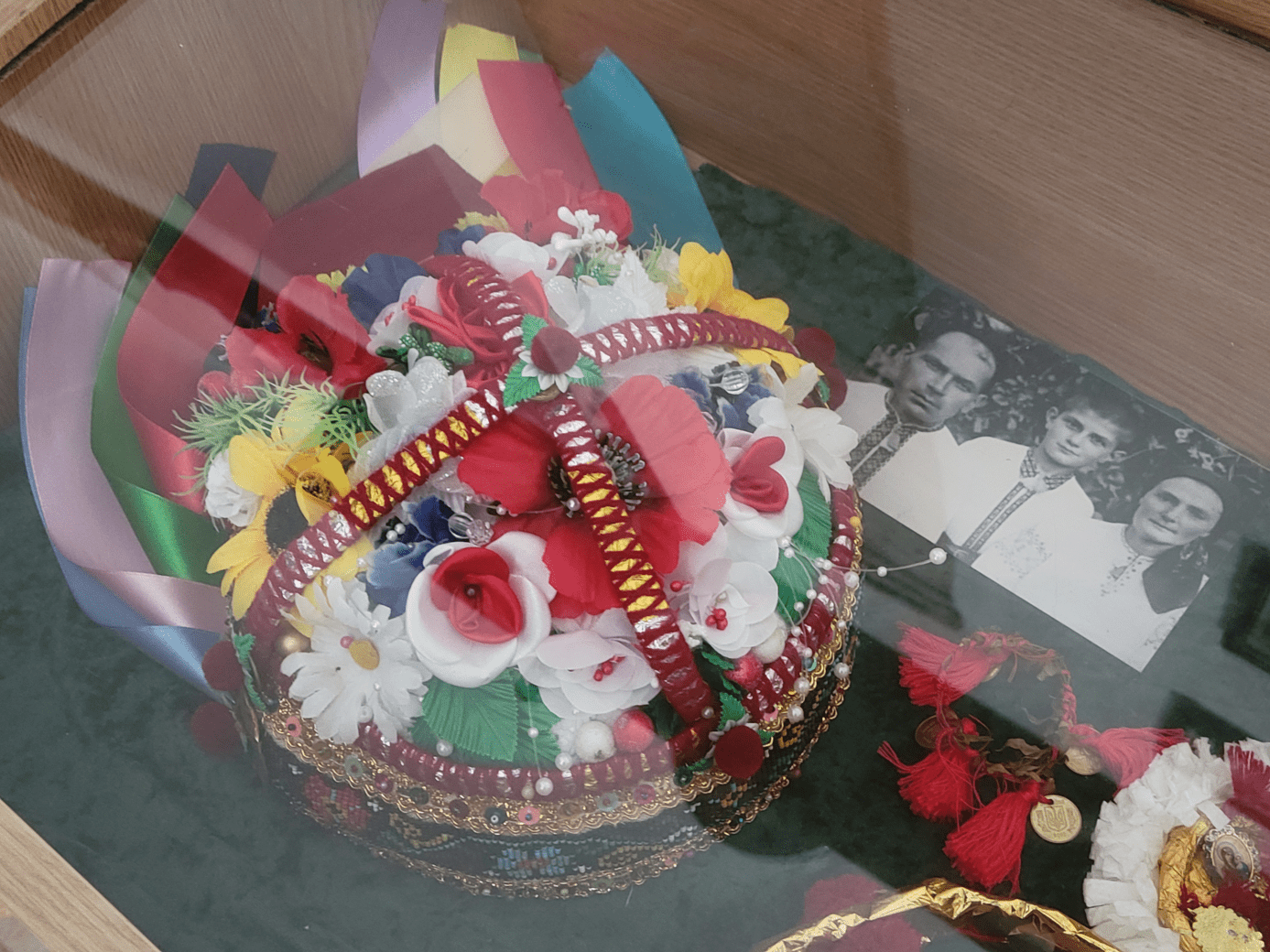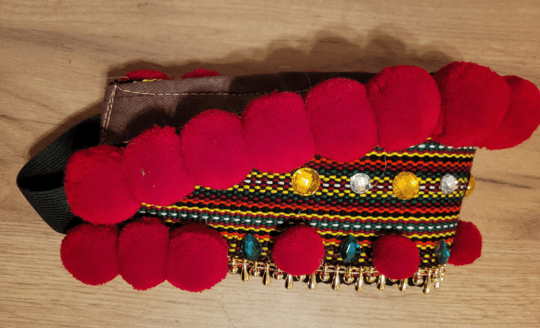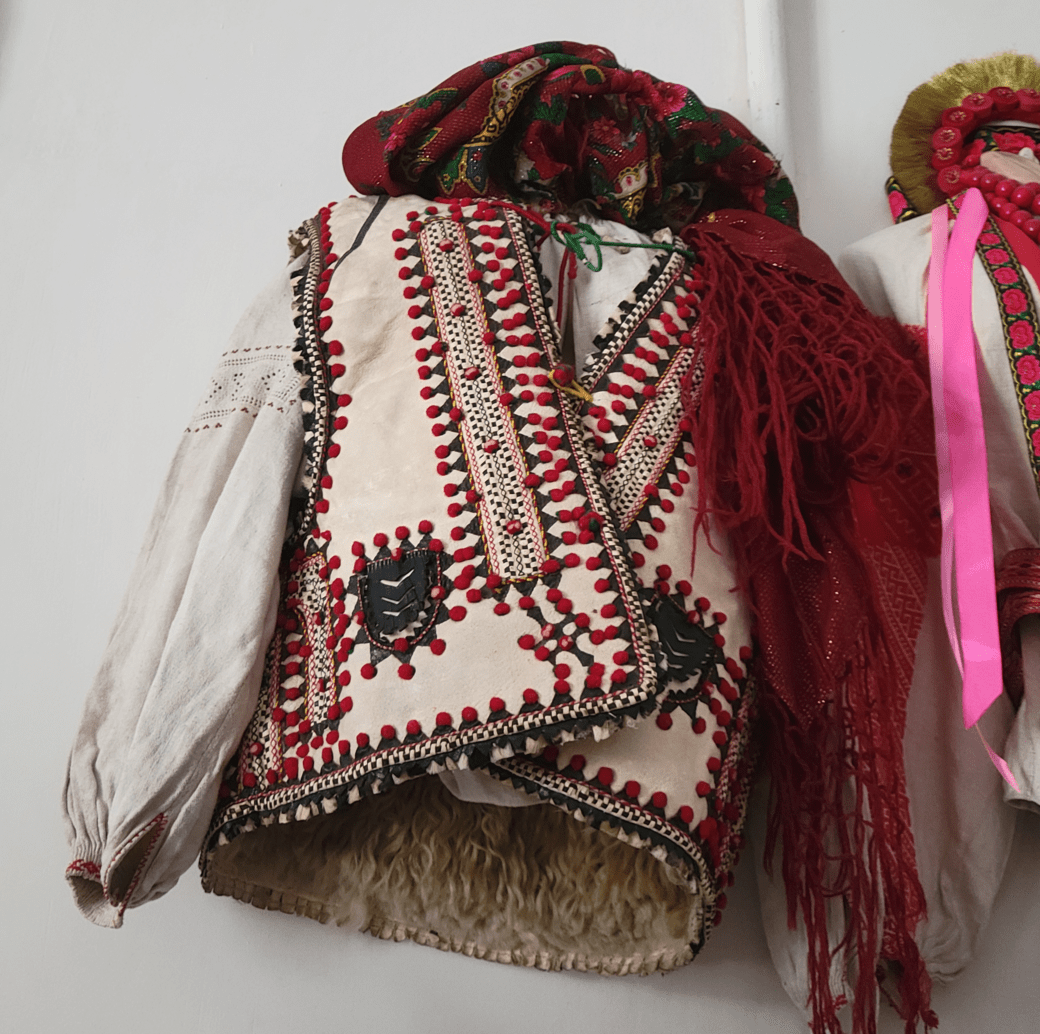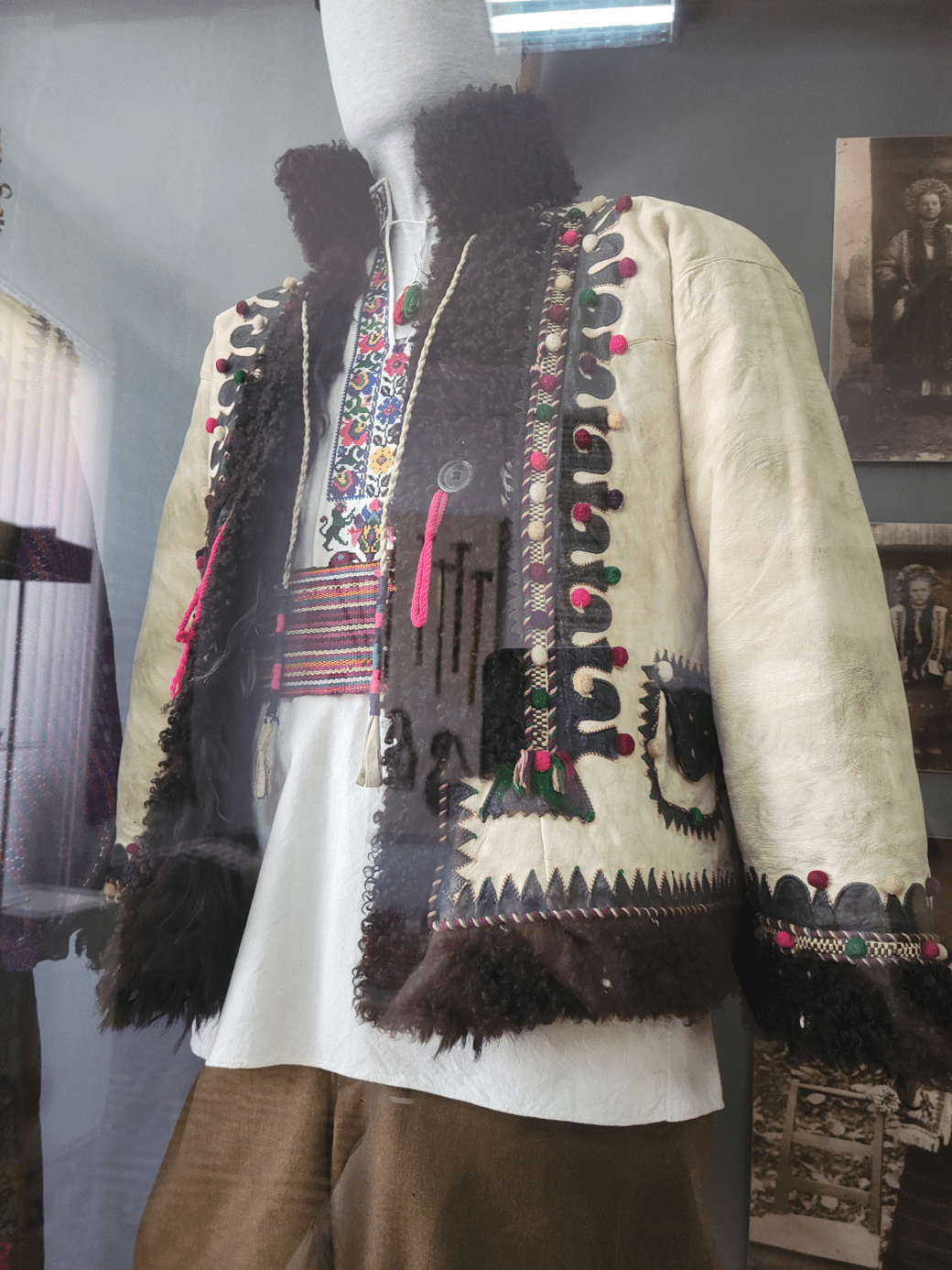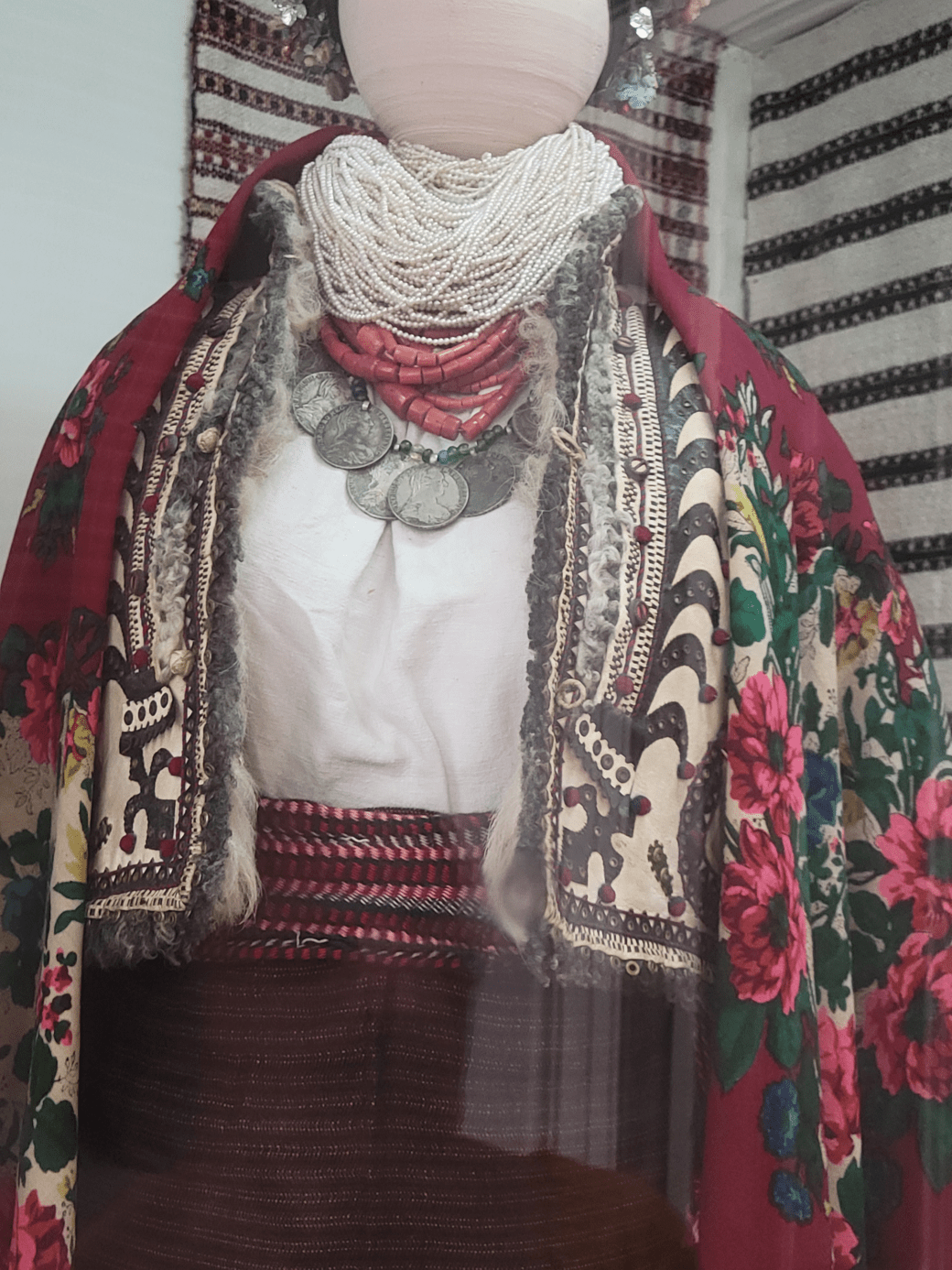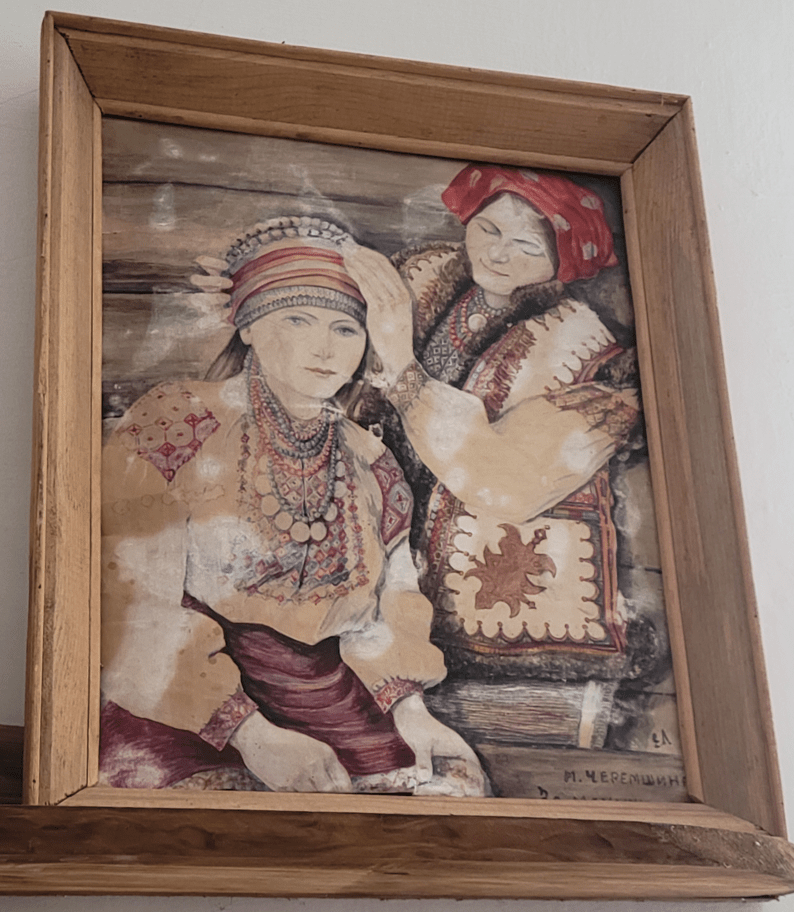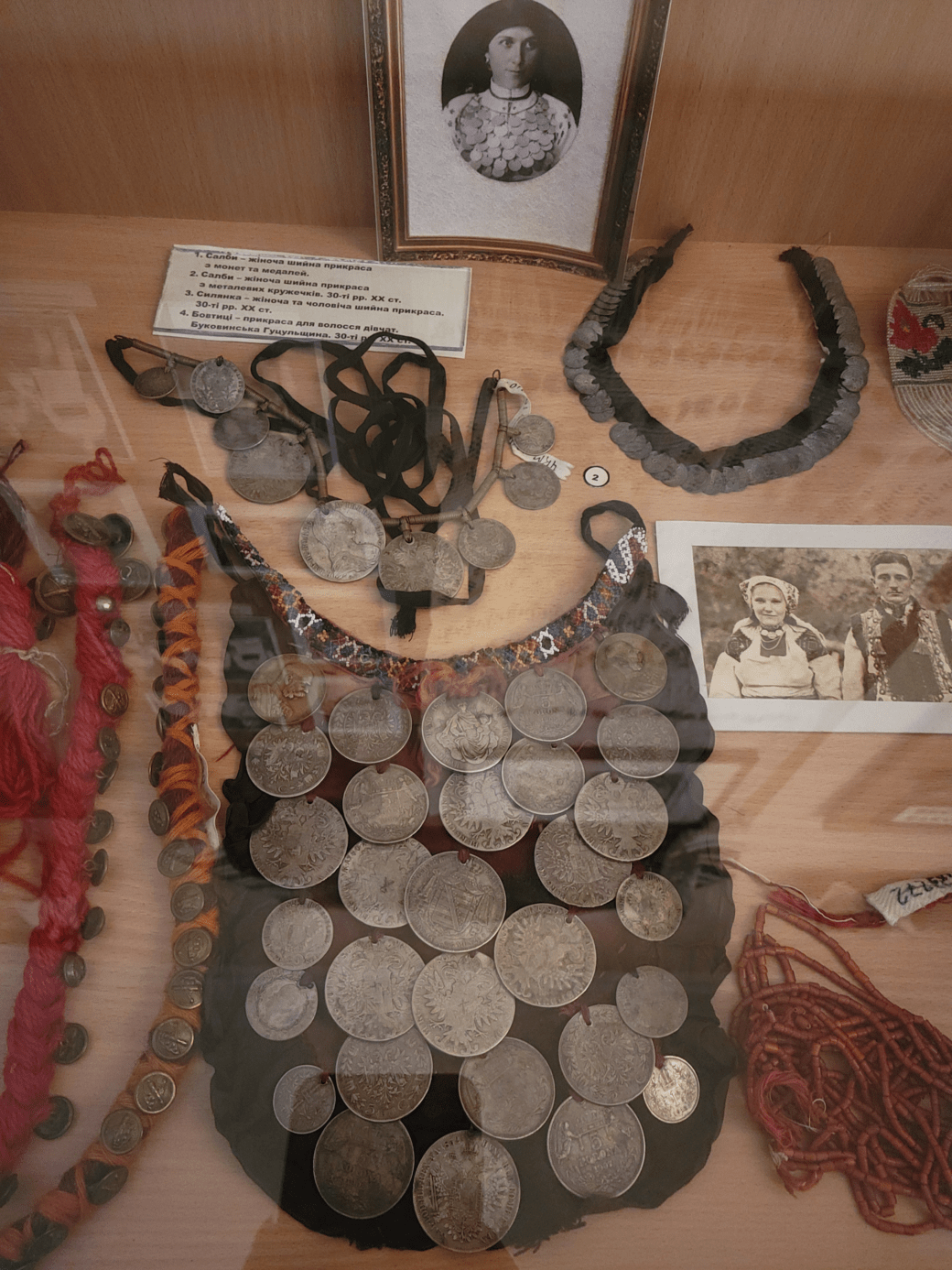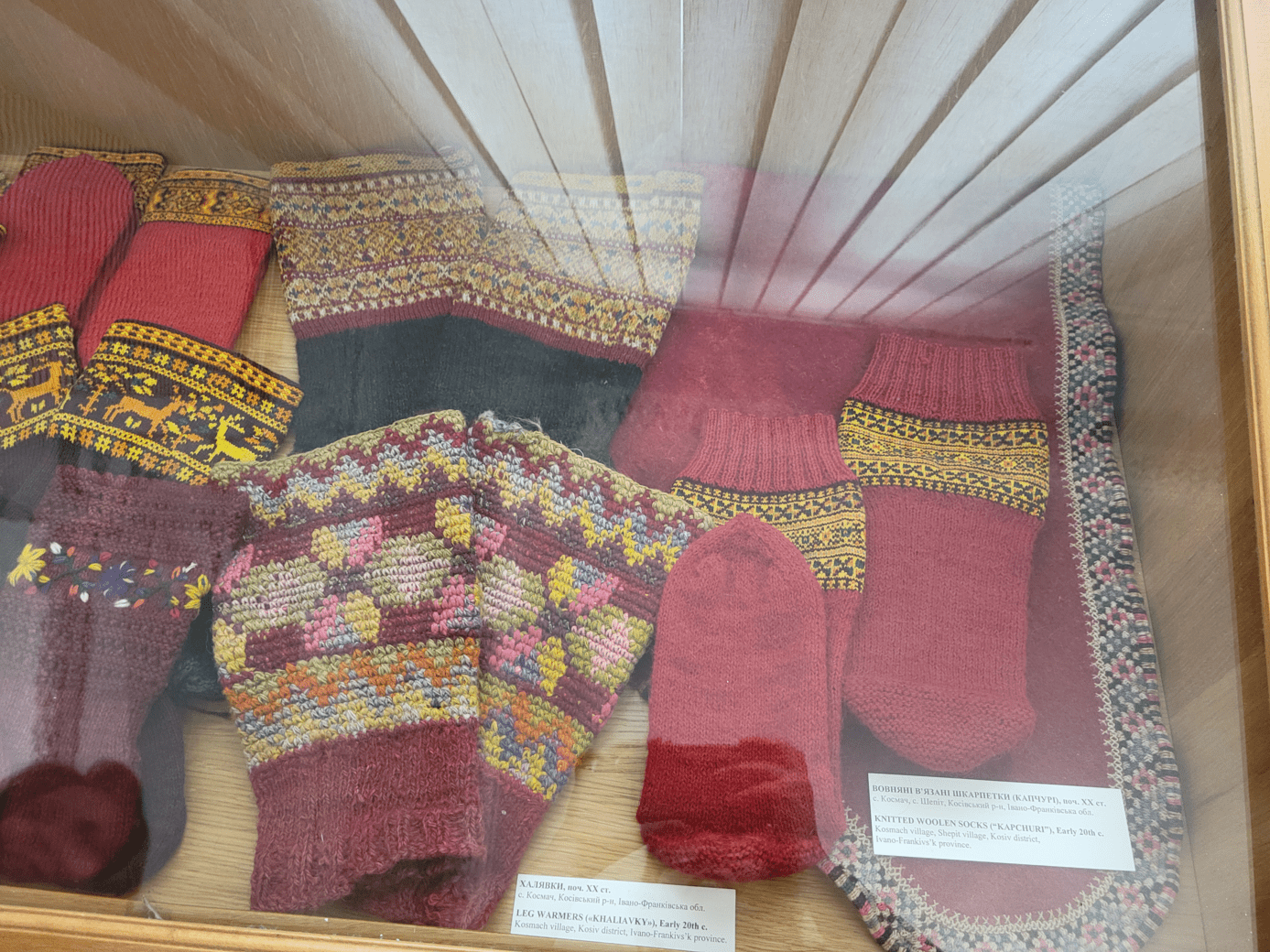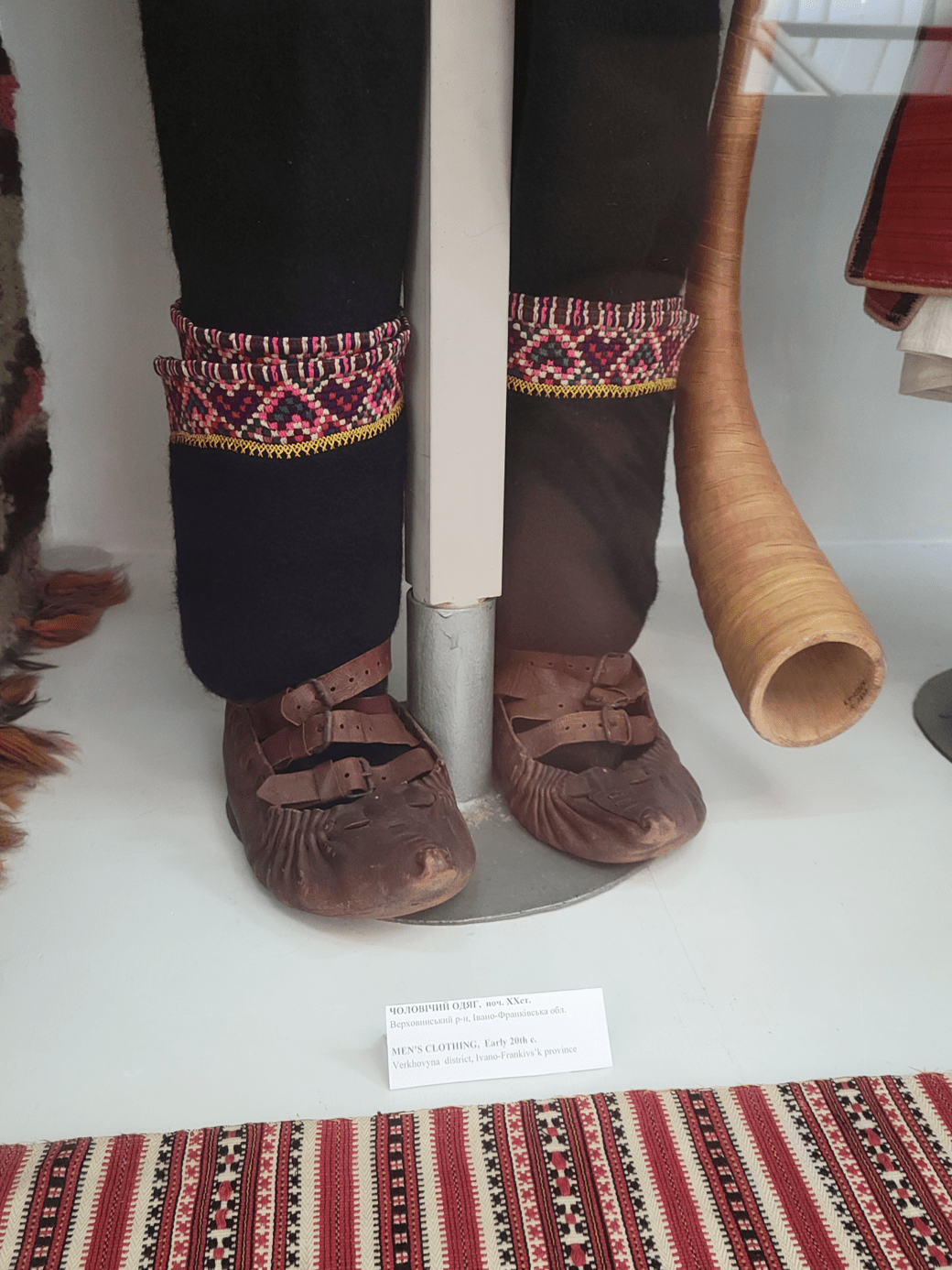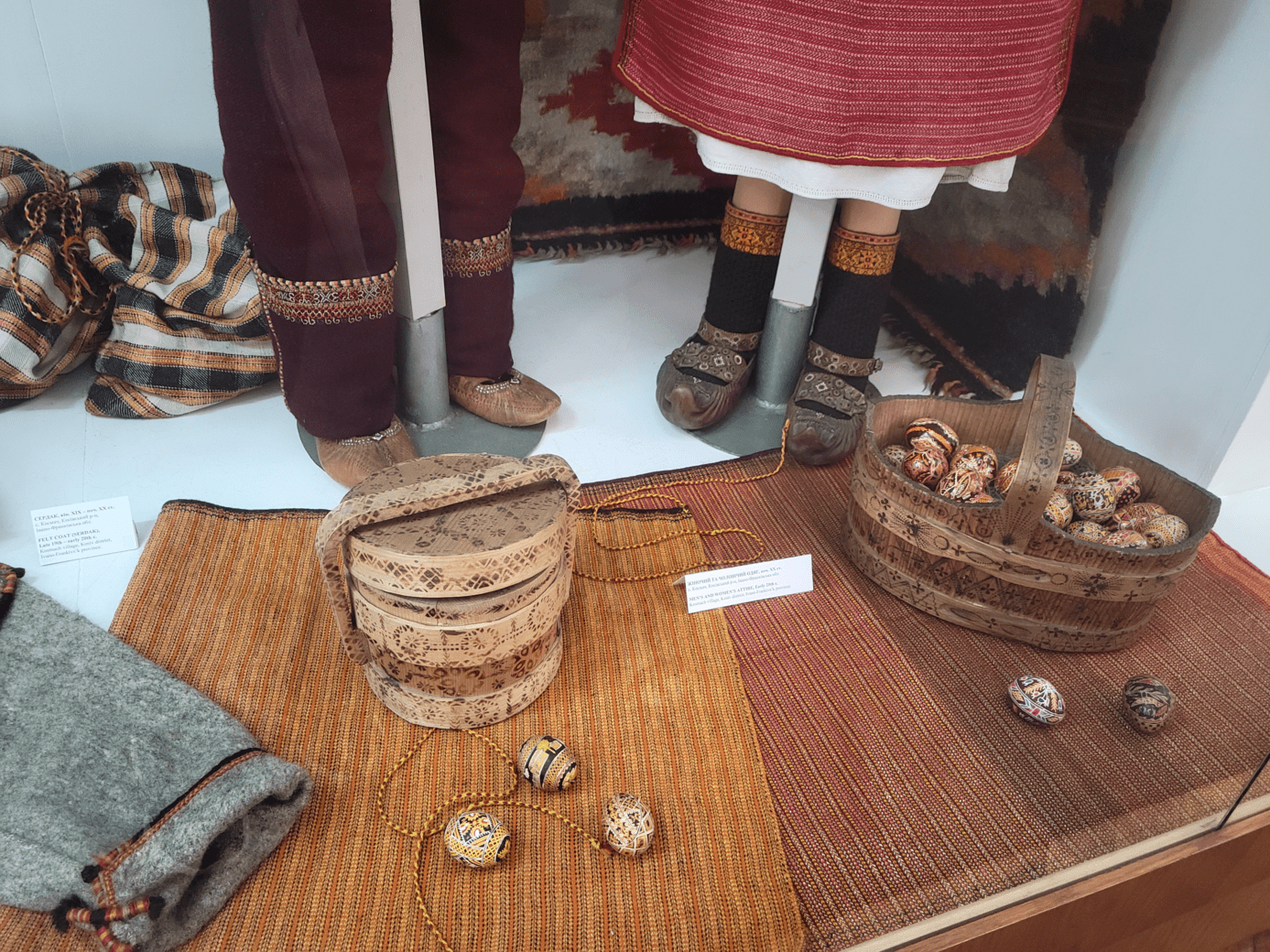Accessories
Collecting, Not Crafting
A rather obvious obstacle to constructing a complete folk costume is that very few people have the free time, resources, skills, and interest to make each part themselves. I am no exception to this obstacle; I knew very early on that I would not be crafting everything myself. My solution to this problem was to buy the missing elements (the belt, jewelry, and headpiece, in particular) from other crafters.
I have not had any real issues or regrets about seeking these parts out elsewhere. First of all, it’s been a reasonable, if not necessary, thing to do historically and today. My circumstances mean that I have to spend a lot of my time working to pay for rent and cat food, as well as studying for my MA degree. Even the fabled days of spending all winter embroidering and sewing have been out of reach for a long time now, and we have to adapt to that truth. The time I have to learn complex skills, like belt weaving, is also rather limited. Ultimately, I must look to crafters with these skills to fill in the gaps and help me achieve my goal; otherwise, this would never come to fruition.
Secondly, relying on other crafters is rather normalized to me, not to mention in the wider Ukrainian society. I know few Ukrainian women today who have embroidered their own vyshyvanka, but I have met many Ukrainians who have inherited and/or purchased vyshyvanky from embroiderers. Obtaining the parts for a folk dress from crafters is common in Western Ukraine, at least; I found an abundance of little shops and stalls readily selling vyshyvanky, necklaces, etc. in Lviv, Ivano-Frankivsk, Kolomyia, and elsewhere. Countless Ukrainian websites and Etsy sellers greatly add to this accessibility. I know well that I’m just one of the very many Ukrainians who rely on professional crafters for vyshyvanky/etc. And considering the old Kosiv Bazar, which has long bustled with new and antique traditional dress, this reliance on the community is certainly nothing new.
A final consideration I have had in this process of collecting in lieu of crafting is that the parts that I do purchase from other crafters are still mine. No, I did not make them myself, but I carefully chose each necklace/etc. Each purchase intended for the folk dress was chosen based on what I knew of the traditional Sniatyn folk dress and my own preferences. And I will readily admit that I am a very indecisive person when it comes to these types of purchases. I’ll stare at 1 thing for longer than one should in a shop, leave and come back, text friends for opinions, and think some more before finally making a move. I can guarantee that a lot of thought and care was taken into each choice, and after all of this, I do feel a connection to these items. I treasure the items I purchase from other crafters. And I perceive them as much a part of the final folk dress as I do my own vyshyvanka and silyanka.
Ideals
When I started planning out my folk dress and its separate parts, I figured out pretty quickly that the belt and jewelry would have to be purchased. My lack of time, resources, and specialized skills (and for the jewelry, interest) would simply not support my trying to make these items on my own. But since I would have to source these items elsewhere, I wanted to make sure that I was careful with where I purchased them.
An obvious decision was to buy only from Ukrainian sellers. Luckily, things like the region-specific woven belts and necklaces are usually only sold by Ukrainians anyway. A second decision was that I wanted to try my best to support crafters and limit my purchases of mass-made items. This could be a bit more difficult to ascertain; after all, even if the seller is Ukrainian, I can’t always know the history of the item. With that said, when purchasing the belt and necklaces, I often researched the seller/crafter and asked questions from the vendors whenever I had the chance.
A final note here is that I had planned to buy these items whenever possible in Western Ukraine from the start. An obvious benefit was that I was able to find local crafters who did not always have a social media presence and meet them myself. It also saved me extra shipping costs, which is an important consideration when working with a student budget. Moreover, I would be ensuring that my money would be going straight into the Ukrainian economy, which I imagine could use it at a time when international tourist levels have declined sharply. This is all to say that I planned ahead as much as I could to make sure I could meet my expectations.
Belt
So, the final belt for this dress was not purchased while I was in Ukraine, actually.
Approaching the belt for the Sniatyn region is tricky. While I’ve been able to find out quite a lot about the local embroidery patterns, the silyanky, and even the opynka, the belt is more of a mystery. If I had to summarize what I know about traditional belts from all the photos I’ve seen, it would simply be: wool, handwoven, geometric patterns, & predominantly dark red, orange, or black with other colors included to a lesser extent. As discussed on my opynka page, the belt would have been color-coordinated with the embroidery. That’s really not much to go on. And while I’m by no means a weaver, my experience with a rigid heddle loom and figuring out the inkle loom is enough for me to say that I would have very little to work with here regardless. There are few documented belts from Sniatyn and, of the ones I got to view, I only caught partial views.
I did find out a lot more in Kolomyia. On display at the National Museum of Hutsulshchyna and Pokuttya Folk Arts is a loom that was being used by an elderly woman to make belts. She had donated it to the museum when she could no longer weave so that younger generations could see how belts were made. To the best of my knowledge, there are no remaining belt weavers in the region. While not technically a floor loom, that loom is still a little beast. It has multiple shafts (I’m assuming 4), a far cry from the simple inkle loom that I possess. I honestly have no idea how I would even source that loom, especially outside Ukraine, or if pick-up weaving would be suitable for the patterns instead.
No way. There was no clear start to learning to weave the belt, and knowing how long belt weaving takes, there would be no quick ending either. The belt would have to be obtained elsewhere, following my best approximation of what it should look like based on what little I do know.
The first belt I purchased for this dress was in a tourist shop in Ivano-Frankivsk. It’s dark red, acrylic, too narrow, and the weave is so loose that the belt is unsettlingly stretchy. It was cute to pair with my regular clothes, but it had so little substance to it. This belt is a large part of the reason why I planned out my opynka so that it could be buttoned; there was no way that I was going to rely on the stretchy belt to hold up a full woolen skirt. I did not find another suitable belt during my time in Ukraine. And I dropped the matter for a while.
Sometime after finishing my opynka, I decided to start scouring the internet for a better belt. The more I thought about the narrow belt being paired with my heavy skirt, the more it bothered me. I wanted a woolen belt because it would match the original belts more closely, it would be stronger, and it would be more environmentally friendly. But searching for a suitable belt isn’t easy. I had a really hard time finding one, let alone one in my budget. The majority of the belts I found looked way too similar to the one that I had already purchased in Ivano-Frankivsk. And only some of the sellers would admit that they were using acrylic yarn in their descriptions. It was a frustrating process, and I only bothered with it sporadically.
After the nth time searching through Etsy, using a variety of English and Ukrainian words to try and widen my search, I settled on one shop based in Kosiv. There was no woolen belt to be had, but the seller had handwoven acrylic and cotton belts, designed the belts herself, could tell me what loom was used for weaving the belts, and had good reviews. Okay, this was as close as I was going to get for now. She offered a burgundy and white belt that matched the general aesthetic of a few of the belts from Sniatyn that I had seen, matched my opynka design, and was wide enough to match most of the local belts I had seen in Pokuttia. After a month or so of contemplation and ensuring that she was the best choice for this matter, I decided to purchase the burgundy and white belt. I am very happy to report that this belt is of a much higher quality than the first one. It is, unfortunately, made from acrylic, but it was also within my budget and met every other preference of mine, so I won’t complain.
And with that, I finally have my belt! This belt will now be used to secure my opynka in place. When fastening the belt, it should be folded and arranged. Knots should not be added; tie up the belt and you tie your fate.
Jewelry
Jewelry, especially necklaces, is an extremely important part of the aesthetic of the Sniatyn folk dress. As briefly discussed on my page about the silyanka, there are a few different types of necklaces in Ukrainian folk dresses, many of which are commonly found in the Sniatyn region as well. Historically, necklaces have been essential for Ukrainian women, as they wore necklaces for both special occasions and just the ordinary day. Since a lot of these necklaces, especially the coral bead necklaces, were imported, it was costly to obtain them. So, these necklaces were a status symbol for women, signaling the family’s prosperity according to the number of necklaces worn.
Coral Bead Necklace
Among the different types of necklaces worn historically in Sniatyn, the coral bead necklaces (korali) are definitely the most popular and recognizable in the bunch. Ukrainian women have worn them for centuries to symbolize their youth, health, and prosperity. The coral for the necklaces was imported from the Mediterranean and Red Seas, with the price tied to its quality and brightness of color. They were then strung into rows of beads on silk cording, with smaller beads placed at the edges and larger beads grouped in the center. Some of these necklaces also featured bronze beads in between the coral ones. They were tied around the neck with the cording.
Even women in lower economic classes wore at least two rows of these beads as a part of their typical outfit. But wealthier women could have up to 35 rows of beads, roughly the same price as a pair of oxen or even a house. Women would especially wear corals in their youth, then become more modest over the years. The initial cost for these coral necklaces would be worth it for the family, as many of these necklaces have continued to be passed down to younger generations as family heirlooms.
Imitation coral beads began to appear in the late 19th century, with sealing wax, horn, and smalt standing in for the coral. In more recent times, these necklaces have been produced with artificial (plastic/ceramic) beads, which hold their bright red color and can be sold at a lower price. Many contemporary folk dresses now incorporate these artificial korali, including my own.
While visiting Western Ukraine, I found multiple korali to use in my dress, two of which are the more standard construction of multiple beads strung into rows, and another one that has a more complex construction:
-
I purchased the first one from a small vendor at the Saturday market in Kolomyia. It has 3 strands of varying lengths; at its longest, it is 14 inches / 36 cm. The beads are artificial, and the string used is probably elastic, as it is quite stretchy – this is necessary since the necklace is closed completely. The majority of the beads are a glossy bright red, which are small towards the back of the necklace and become larger towards the center, as they did historically. Each strand has a limited number (10-14) of small black beads evenly interspersed around the center. The addition of black is what drew me to this necklace, as I had not seen any modern coral necklaces include black before, but I think this makes sense now considering black’s prominent role in our textiles. This necklace was ₴250 (€5.90 / $6.32). The vendor herself was very sweet and did the best she could to speak with me, despite my broken Ukrainian.
-
The second standard necklace is from a Ukrainian souvenir shop in the Bastion in Ivano-Frankivsk. Of these three necklaces, this one is perhaps closest to the historical originals without being the real thing. It has 10 strands of roughly the same length. At 10” / 26cm, it is a bit shorter than the first necklace. The cording is a matching red and made of a natural material (assumably cotton). It closes in the back with a lobster clasp. All of the beads are the same red color and size. I suspect that these vendors obtain their beads from the same manufacturer, as the red beads all have a similar design to mimic real coral. This necklace was ₴205 (€4.83 / $5.18).
-
The third necklace is from a craft and vyshyvanka shop in Kolomyia (Магазин Вишиванка). It appears to be a more modern interpretation, as I have not seen any like this in historical photos. However, I do know that this style is growing more popular in Ukraine; I have seen multiple crafters handmake coral necklaces in this style over the last few years. This necklace has the same artificial red beads as the other two necklaces, though this one does not vary bead size. The cording is twine. This necklace is shorter than the other two and ties at the back, like the historical necklaces, so that it should sit right at my collarbone when tied tightly. The beads are not strung straight together but knotted together in an elaborate manner that utilizes the twine in its design – I believe with some type of netting / tatting. While it was likely not practiced historically, this innovation is clearly becoming increasingly popular among crafters in modern Ukraine, and I want to participate in and support innovations that improve and keep our older traditions alive. This necklace cost ₴350 (€8.25 / $8.84).
Lusavka Necklace
In some regions of Ukraine, real mother-of-pearl necklaces (balamuta) were worn with the folk dress. Starting around the late 17th century, these pearl necklaces would be worn together with the coral necklaces. The most valuable of these sported large pearls imported from the Persian Gulf. They would have 5+ strings of pearls and occasionally add coins as extra decoration. These pearl necklaces were rather expensive, of course, and so were worn by women in the nobility.
When the more affordable glass imitations of pearl necklaces (lusavka) became available, women in Pokuttia adopted them into their folk dress. Traditionally, the glass beads were white with a silver coating inside, thus mimicking real pearls. The lusavka is also combined with coral bead necklaces, though they would be piled up against the neck while the coral beads were given the spotlight. To see how the many lusavka necklaces look with the full Sniatyn ensemble, I recommend this video from the project Spadok.
While I did not get a lusavka, I did find an innovative necklace for this aesthetic while visiting a small stall in the Bastion in Ivano-Frankivsk, which is in the photograph above. And in retrospect, I’m not sure if I found any lusavka necklaces while visiting Western Ukraine; most crafters and vendors today focus heavily on offering coral bead necklaces and multicolor bead necklaces (silyanka / gerdan / etc.). I will have to look more in the future. But for now, the necklace I did get satisfies the older aesthetic. This necklace has 10 strands of red and white beads, held together with crocheted black thread. It closes with a lobster clasp and measures 10” / 26cm long. The combination of red and white beads mimics both the lusavka and coral necklaces at once, which makes sense considering these two necklaces were worn together so frequently in the region. While it would be nice to have a multi-strand lusavka in the future, for now, this necklace is an effective way to achieve the aesthetic. This necklace also cost ₴350 (€8.25 / $8.84).
Gerdan
Since I discuss the gerdan and other beaded necklaces at length on the Silyanka page, I will not be describing them as much here. Needless to say, I was not prepared to craft my own gerdan with my current bead loom and skills, so purchasing a gerdan was my best option. My gerdan is from Магазин Гойра & Карпатські сувеніри in Ivano-Frankivsk. I chose a black, red, and white gerdan with a geometric pattern, as it best matches the embroidery on my silyanka. This necklace also cost ₴350 (€8.25 / $8.84).
Earrings
Young Ukrainian women were expected to wear earrings, and had their ears pierced very early in childhood. The most common earring types were crescents and flowers. They don’t tend to have as much highlight as the necklaces in the Sniatyn region, but earrings are still important to include here.
Luckily for me, I had my ears pierced as well when I was very young and have an extensive earring collection going back several years, so I’m not very inclined to worry about this.
So, along with my silyanka, I’m certainly well on my way to an adequate jewelry collection for my Sniatyn dress. But there is still work to be done in the future!
The Crown
There are a few different choices when it comes to headdresses in the Sniatyn folk costume, differing across wealth status, age, context, preference, etc. In the museums I visited, I found caps heavily decorated with beads, flowers, feathers, coins, metal plating, and ribbons for wealthy women. In archival photos, brides from yesteryear wear elaborate headdresses made of flowers. Married women were expected to wear caps (ochipok) over their hair; these caps varied widely in style and how they were worn. However, since I am unmarried, I will be focusing on the options offered to me here. Here are a few such options on display at the Sniatyn literary museum:
To be clear, unmarried women were not required to wear a headdress, especially in their everyday life. Headdresses were an extra bit of decoration for important celebrations and festivals. But we’ll go forward with the assumption that wearing a headdress is desired. Before putting on any headdress, the wearer would first braid her hair with red wool yarn, then plait it over her head. This process is shown in detail in the aforementioned Spadok video. Once the hair was braided, there were a few different options on what type of headdress could then be added:
1. One common option that I have found, both historically and in the present day, is to wear a silyanka or two in one’s hair as a headband. Historically, this option was reserved for unmarried girls. Here is an example of this from the Horodenka region, on display at the National Museum in Kolomyia:
2. A second option is the vinok, a flower wreath with (usually) ribbons. The historical vinok was reserved for unmarried girls/women as well as brides. The average vinok is made of flowers (either real or artificial, such as paper), has ribbons of different colors attached at the sides and back, and in some regions, might be accompanied with embroidery and other decorations. Each vinok was unique to the wearer and featured carefully selected flowers to symbolize her identity, experiences, personality, etc.; I’ll leave this introductory page here for the reader looking to know more. This article on the vynok is also quite interesting. Nowadays, the vinok has been heavily tied to the 2014 Revolution of Dignity and the Ukrainian nation, which is important to know for understanding the modern context of the vinok.
The vinok meant for weddings (vinchannya), and now for fashion photo shoots, is much more elaborate, with flowers piled high in several layers. During the wedding, the vinchannya would be replaced with an ochipok – a fabric cap that covers the head and usually incorporates embroidery. I’m not going to be having a wedding anytime soon, so we’ll be moving on now.
3. And a final option is to obtain a crown more elaborate than the silyanka. These crowns have fabric as their base, then add embroidery, beads, long ribbons, pompoms (perhaps to mimic flowers, such as the guelder rose “kalyna”), and other decorations. These crowns are worn at festivals and other celebrations. A girl wearing one of these crowns at a festival can be viewed here. Here is one such crown on display at the literary museum in Sniatyn:
While these crowns have historically been handmade, it’s possible to purchase them quite easily nowadays. I was able to obtain one from Etno Файно Style in the Bastion in Ivano-Frankivsk for ₴500 (€11.82 / $12.63).
At the moment, I have some variation of all three options (silyanka, vinok, and crown). Only the vinchannya is definitively tied to one context, weddings. The crown appears more sparingly outside of weddings and festivals, so the silyanka seems to be a more solid choice for adding a bit of decoration to the folk dress in less festive contexts. While all three options are great for my Sniatyn dress, I am inclined towards the silyanka option.
And with that, we have covered the accessories that I obtained elsewhere to complete my folk dress.
What’s Missing
As you might expect, pulling everything together for this dress would be time-consuming and require a lot of financial resources on my end. So, there are some elements of the historical dress that are missing. Some of these components are things that I would love to learn to craft someday and thought I would mention here.
Keptar
As mentioned elsewhere in these pages, the keptar is the white sheepskin vest that accompanies folk costumes across Pokuttia and the Hutsul regions. For these vests, the actual fleece is turned inwards towards the wearer so that embroidery may be added to the smoother side of the skin. The photo above shows the keptar on display at the M. Cheremshyna Literary Museum in Sniatyn. For the Sniatyn region, these vests are decorated with red and black embroidery. Extra red ornamentation is added around the vest to symbolize the kalyna (guelder rose), which is a historically important part of Ukrainian folk culture.
It is interesting to note that, aside from the different sizes, the keptar is a rather gender-neutral item; both men and women wear them, and there are no real differences between them beyond sizing adjustments. The keptar would be decorated as nicely as possible so as to impress others – so, a fashion statement. They could be worn year-round, weather permitting; in colder weather, they were worn with sleeves, such as this one on display at the Museum of Hutsul Folk Art and Way of Life in Kosiv:
If I had crafted one myself, it would easily have a full page to itself. The technical skill and patience that crafting a keptar must take astounds me, and I really do hope I gain enough know-how someday to make my own. For now, it will have to be relegated to this little section, a hopeful bookmark for the future.
More Necklaces
After my earlier section on the lusavka, it shouldn’t be a surprise that I’m missing necklaces. The lusavka is an easily identifiable one that I am currently lacking. But there’s another that I’m also missing: dukaty (дукати). This necklace consists of ~5 or so coins strung onto woolen thread along with beads, coral, or even crosses. Here is a historical example of the dukaty (plus other necklaces) from neighboring Kolomyia:
And an illustration of a Sniatyn woman wearing the dukaty, on display at the Sniatyn literary museum:
The simpler dukach tends to be more commonly discussed. The dukach consists of a single coin attached to a velvet ribbon and combined with beads. This coin would be an Austrian ducat / Russian ruble (depending on the region) or a silver medallion depicting the Virgin Mary, various saints, or biblical scenes. These necklaces were status symbols and worn with pride, so they were carefully placed above the rest of the necklaces to show them off. They were often used as dowries and passed from generation to generation.
I will admit, I’ve been interested in coin necklaces since discovering the Udmurt monisto (coin necklace). While these different coin necklaces are likely from Turkic influence (Armenian for the Ukrainian context, I assume), I just think there’s something so innate about people wanting to wear coins – shiny and ornate symbols of status – and pass them down in the family. And it’s so fascinating to me that just 30km from Sniatyn, in the Bukovynian region of Zastavna, the salba is worn. The salba is made of a bit of handwoven, usually red fabric, upon which up to 120 coins (!!!) would be sewn, along with beads, and worn over the chest. I won’t lie, I do feel some jealousy when I look at them. Here’s an example of one on display at the ethnographic museum in nearby Chernivtsi:
But luckily for me, the region does excel in dukaty necklaces. They are pretty consistently found in old photos and art of the Sniatyn folk dress. Usually only one dukaty necklace is worn, but there are some women, such as this one, who wore multiple dukaty necklaces at once (notice also that her sleeves only have the inset). Which is all to say that I hope to add dukaty necklaces to my collection someday when I have the resources and time to make my own.
Legwarmers
While visiting the aforementioned National Museum in Kolomyia, I was able to view a collection of really beautiful handknitted legwarmers. They’re so colorful and feature various unique and complex patterns. I had never encountered these legwarmers before during my research; it is likely the opynka would hide them for the most part anyway. I had not come across even a single mention of them before my visit to the National Museum. And it was really cool to see these stunning legwarmers from the region! I had discovered something entirely new from the region to be proud of!
But I’m not a knitter! I’ve tried. I’m not a bad knitter, but it annoys me so much in comparison to embroidery and crochet. Maybe someday I’ll try to learn to knit well enough to make my own legwarmers in this style, but that’s not happening anytime soon. Nor do I even know how to source them? I’m serious when I say I’ve never seen the legwarmers before, and I wouldn’t be surprised if they’re not made much anymore.
It should also be mentioned that the deadline for this project is in June, when legwarmers will (hopefully!) not be needed. Trying to find them simply wasn’t a pressing matter for this project.
Regardless, I wanted to show them here in case any knitters wanted to see Pokuttia and nearby knitwear. While I do not have any photos of samples from Sniatyn specifically, here are a few examples from nearby regions:
